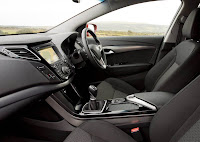Audi launched the next generation of the Audi A6 Avant, the most
successful business-class station wagon in Europe. The new model
presents the brand's full array of progressive technological expertise.
Its lightweight body, large portions of which are made of aluminum, sets
new standards, as does the wide selection of assistance and multimedia
systems. The keyword for the latter is Audi connect. The new Audi A6
Avant is available with a choice of six engines: two gasoline engines
and four diesel units. Fuel consumption has been reduced by as much as
18 percent compared with the previous model. Topping the engine lineup
is the new 3.0 TDI with twin-turbo technology and 230 kW (313 hp). Audi
also offers numerous high-end options for the drivetrain and the
chassis. The luggage compartment has a capacity of up to 1,680 liters
(59.33 cu ft) and offers a number of elegant features, including a power
rear hatch that opens in response to a sensor signal.
The new Audi A6 Avant - Progressive technological expertise
Audi is once again leading the way, with the new A6 Avant the trendsetter in the business class. With its lightweight body and many additional innovations, the seventh-generation Audi A6 Avant is intended to write another chapter in the model series' history of success.
Measuring 4.93 meters (16.17 ft) in length, the Audi A6 Avant makes a very agile first impression. Its proportions are sporty, and the low roof line flows into flat D-pillars. Audi offers LED headlights and rear lights as a visually and technically fascinating option.
The new Audi A6 Avant - Progressive technological expertise
Audi is once again leading the way, with the new A6 Avant the trendsetter in the business class. With its lightweight body and many additional innovations, the seventh-generation Audi A6 Avant is intended to write another chapter in the model series' history of success.
Measuring 4.93 meters (16.17 ft) in length, the Audi A6 Avant makes a very agile first impression. Its proportions are sporty, and the low roof line flows into flat D-pillars. Audi offers LED headlights and rear lights as a visually and technically fascinating option.


























































